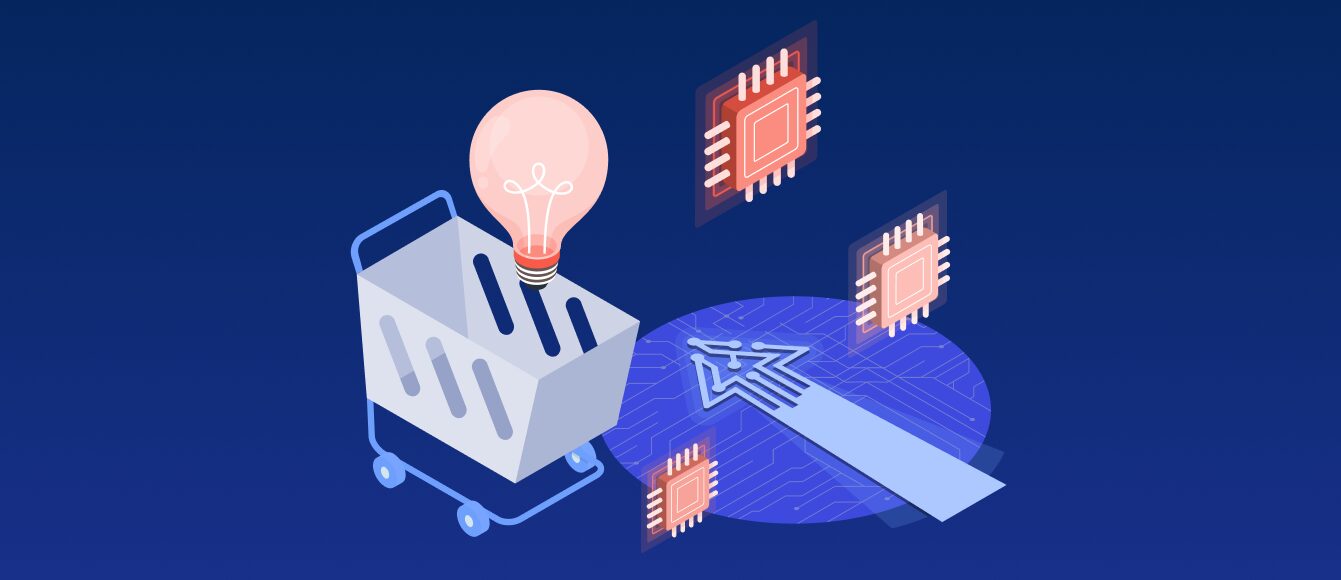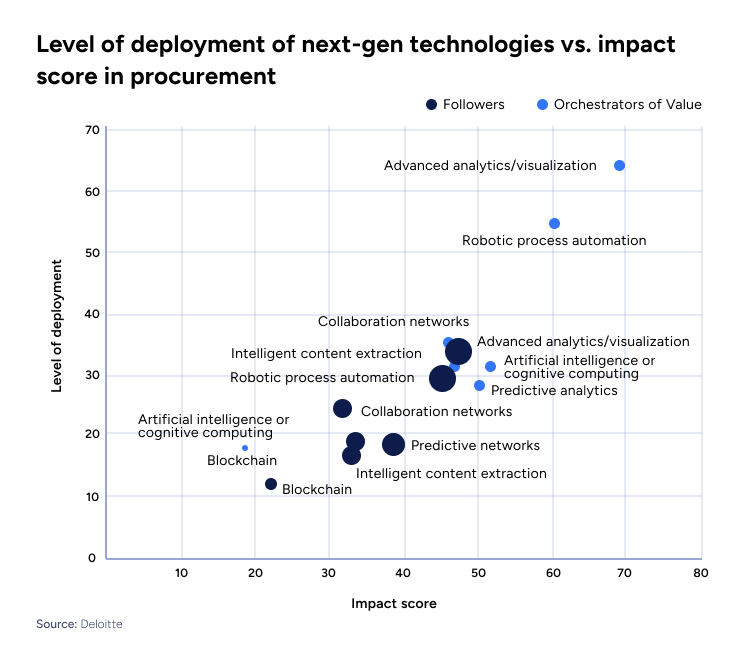Everything to Know About AI in Procurement



Artificial Intelligence is driving a significant transformation in procurement. From automating repetitive tasks like invoice processing to enhancing spend analysis and supplier management, AI is helping procurement teams become more efficient and cost-effective.
According to the 2023 Global CPO Survey, 92% of Chief Procurement Officers (CPOs) are planning or actively assessing the implementation of AI in procurement, with a focus on generative AI. 11% of organizations globally are already investing over $1 million annually in generative AI, and this number is expected to more than double by 2025, with 22% of CPOs planning similar investments.
Among those experimenting with AI, 38% are focusing on AI-driven spend dashboards, and 19% are automating Request for Information (RFI), Request for Proposal (RFP), and Request for Quotation (RFQ). This early adoption enables to streamline complex tasks, reduces manual intervention, and enhances decision-making.
However, the gap between planning and execution remains significant. Currently, only 37% of CPOs have piloted or fully deployed AI within their procurement processes. In this article, we will explore how AI can add value to procurement processes, answering these questions:
- What are the most impactful use cases for AI in procurement?
- What are the main challenges in adopting AI in procurement, and how can they be overcome?
- How can companies prioritize and successfully implement AI use cases?
- What steps can businesses take to ensure the successful long-term adoption of AI in procurement?
AI is at the Forefront of Digital Transformation in Procurement
Procurement is undergoing a rapid digital transformation. According to Deloitte:
- Orchestrators of Value are procurement leaders who excel in digital transformation, data-driven decision-making, and proactive risk management, often using advanced technologies like AI at a much higher rate than their peers.
- Followers are procurement organizations that need to adopt digital strategies and advanced tools, focusing more on traditional procurement methods and implementing digital innovations only after being implemented by the orchestrators.
55% of “Orchestrators of Value” rank digital transformation as a top-three priority, compared to 36% of Followers. Orchestrators have deployed RPA at 10 times the rate of their peers and AI at 16 times the rate. Predictive and prescriptive analytics are notable areas of AI impact, with Orchestrators adopting these technologies at three times the rate of less advanced organizations.

Among the most impactful technologies, AI is at the forefront, with advanced analytics and robotic process automation (RPA). AI in procurement is for instance applied to intelligent content extraction, the practice of using AI to automate the process of pulling structured, usable data from unstructured documents like contracts and invoices, where Orchestrators deploy it five times more than their peers.
How AI Adds Value in Procurement
Types of AI in Procurement

Artificial Intelligence encloses a range of technologies with multiple applications and use cases. The five main types of AI in Procurement, and their applications are the following:
- Machine Learning (ML) identifies patterns from procurement data, predicting trends and outcomes. This is crucial for demand forecasting, supplier selection, and cost optimization.
- Robotic Process Automation (RPA) focuses on automating repetitive tasks, like invoice processing and order approvals, freeing procurement teams from administrative work. Though RPA is not strictly considered AI, it is often enhanced by it.
- Natural Language Processing (NLP) powers tools like chatbots and virtual assistants, helping procurement professionals interact with systems using natural language. These tools simplify complex processes such as guided buying and contract management.
- Optical Character Recognition (OCR), on the other hand, digitizes procurement documents, extracting data from invoices and contracts, making manual data entry redundant.
- Generative AI is emerging as a major disruptor in procurement, being recognized for its ability to “do things differently” and “do different things.” This includes automating the creation of RFX documents, simplifying contract reviews, and generating purchase requisitions through conversational interfaces. Companies are also building intelligent category workbenches, which use AI to analyze market data and spending patterns, providing recommendations that optimize procurement strategies.
How AI Can Reconfigure Procurement Processes
To understand the specific use cases where AI can add value to procurement, let’s consider one of the most widely used procurement methods, the Source-to-Settle (S2S).
S2S is an end-to-end procurement process that covers everything from sourcing goods and services to the final settlement of payments. The goal of S2S is to optimize efficiency, reduce costs, and ensure compliance across the entire procurement lifecycle.
Although varying widely across industries and businesses, opportunities for implementing AI exist across all stages of the S2S lifecycle: demand analysis, sourcing strategy, invoicing, monitoring, payments, and contract management.

1. Spend Classification and Enrichment
AI is transforming the spend classification process by automating data analysis, a task that used to rely heavily on manual inputs. AI algorithms can sort through vast amounts of procurement data—like item descriptions, account descriptors, and supplier names—and classify them into specific spending categories using natural language processing (NLP) and Gen AI.
With an average of 97% accuracy in data categorization, AI becomes a key tool for companies struggling to analyze large volumes of unstructured spend data - as they enable manual tasks drastically. In addition, AI also enables to include other external but relevant dimensions into spending data such as sustainability, thus helping procurement teams to target products sourced from environmentally friendly suppliers.
2. Sourcing Strategy
CPOs often face challenges in gathering reliable global sourcing insights due to fragmented data from multiple suppliers and industries. AI tools now aggregate and analyze this data from various sources, including third-party licensed reports and publicly available market data, providing comprehensive visibility into sourcing trends.
AI can also highlight shifts in global supply markets, predict commodity price fluctuations, and identify potential supply chain disruptions. This allows procurement teams to adjust sourcing strategies preemptively, leading to better supplier selection and reduced costs. AI-driven insights also enable CPOs to critically evaluate potential savings and supply risks, allowing for more strategic sourcing decisions.
3. Invoice Data Extraction
AI-powered invoice data extraction uses technologies such as computer vision and NLP to automate the process of extracting relevant data from invoices. AI can scan and extract key information such as payment terms, receivables, and supplier details in seconds.
This reduces the manual labor traditionally required in accounts payable and provides organizations with detailed insights into their spending patterns. Moreover, AI helps prevent fraudulent invoices by cross-referencing extracted data with existing procurement records, thus enhancing overall compliance.
4. Automated Compliance Monitoring
AI in procurement can add value to compliance monitoring by automatically comparing purchase orders, contracts, and invoices against organizational policies and external regulations. In companies that have not yet adopted integrated procurement systems, manual compliance checks are more prone to errors.
AI tools mitigate this by identifying discrepancies in real time, flagging non-compliant transactions, and reducing the risk of fraud or financial leakage. This automation improves accuracy, reduces costs related to compliance management, and enables procurement teams to extract more value from contracts through effective monitoring.
5. Contract Data Extraction
In a process similar to invoice data extraction, contract data extraction uses AI to organize unstructured contract information into usable formats. AI scans contracts in various and extracts contract terms, deadlines, and payment clauses using natural language processing (NLP).
This automation allows procurement teams to manage high volumes of contracts more effectively, ensuring that all key contractual obligations are met. Additionally, AI can predict potential risks hidden within the contract terms, helping organizations proactively address them before they become costly issues.
6. Contract Lifecycle Management
AI is optimizing the contract lifecycle management (CLM) process by automating the drafting, reviewing, and monitoring of contracts. AI tools can generate contract templates by standardizing clauses based on company policies, making the review process quicker and more accurate.
NLP can also be applied to analyze existing contracts and highlight potential risks or discrepancies. On average, AI-based CLM systems have reduced contract review times by up to 50%, allowing procurement teams to engage in more strategic negotiations and manage their supplier relationships more effectively.
The Benefits of Using AI in Procurement

AI, especially Gen AI, is poised to transform procurement processes and deliver substantial economic benefits, including:
- Efficiency Boost: AI in procurement can accelerate processes by 4x, allowing faster turnaround on tasks like RFP generation and contract management. By automating repetitive processes such as purchase requisitions and invoice processing, procurement teams can focus on higher-value activities. This is estimated to lead to a 50% improvement in full-time employee (FTE) efficiency.
- Cost Savings and Spend Reduction: AI-driven spend analytics helps organizations achieve 30% higher savings by uncovering patterns in procurement data, predicting future market trends, and identifying cost-reduction opportunities. This helps procurement teams optimize their sourcing strategies and negotiate better supplier contracts, leading to 50% reductions in excess inventory and stockouts.
- Risk Mitigation: AI in procurement can reduce supply chain disruptions by 40% and minimize overall market price risks by 30%, helping procurement teams to proactively address risks before they escalate.
- Sustainability and Compliance: AI in procurement helps promote sustainability by helping organizations lower CO2 emissions by 30% and ensuring 100% compliance with procurement policies. Through automated compliance monitoring and contract management, AI enables companies to meet both environmental and regulatory requirements.
- Supplier Interaction and Innovation: AI fosters more innovative supplier collaborations, improving supplier interactions by 50%. It allows procurement professionals to engage with suppliers more effectively by automating communication and negotiation processes, thus driving innovation and improving supplier performance.
The Main Challenges of AI in Procurement
Despite the benefits of implementing AI in procurement being clear, it often comes with significant challenges, which often slow down progress for organizations trying to transform their operations. The main challenges are the following:
- Data Quality and Access: Many procurement organizations lack clean, centralized data. 21% of CPOs report low data infrastructure maturity, with less than 70% of spend data stored in a single source. Even when organizations consolidate data, they frequently lack essential details such as supplier performance or external market data, limiting AI's potential to make informed decisions.
- Building a Business Case: Procurement teams struggle to secure funding for AI projects because the business case for AI might not be clear. This is particularly true when organizations take a “technology-back” approach, selecting AI tools without tying them directly to measurable outcomes.
- Low Adoption Rates: Even when AI tools are piloted successfully, many organizations face difficulties embedding them into core processes. Teams often resist new technology due to short-term goals or reluctance to change workflows. As a result, many AI initiatives remain stuck in pilot phases rather than becoming fully operational.
How Can Companies Successfully Implement AI
Focus on Addressing Challenges Since The Beginning
Implementing AI in procurement requires a structured approach that addresses data quality, business case clarity, and adoption. First, prioritize data quality by building a strong data foundation. Instead of attempting to overhaul all data systems, focus on cleaning and organizing the data needed for high-value use cases.
To secure funding, procurement teams must build a clear business case that ties AI initiatives directly to business outcomes. This involves demonstrating how AI can reduce costs, improve supplier selection, or mitigate risks, helping executives see the tangible benefits of investment.
Furthermore, give priority to developing a user-centric design. AI tools must be intuitive, easy to navigate, and integrated seamlessly into existing procurement processes to avoid disrupting workflows. Continuous communication and training will help users understand the value AI brings, ensuring widespread adoption. Early quick wins are essential to showcase AI’s potential and build momentum across the organization.
Focus on a Small Number, High-Value Use Cases
Successfully transforming procurement into a data-driven, AI-enabled function requires clear vision and commitment from leadership. Companies should start by engaging internal stakeholders to identify pain points and align on what a high-performing procurement function looks like. This insight allows organizations to prioritize high-value use cases that deliver the greatest impact.
Instead of attempting to implement numerous AI solutions at once, focus on a handful of high-impact use cases that generate immediate value. Leading organizations often focus on use cases like predictive analytics, spend categorization, and risk management, which can provide early returns. To do so, consider building a dedicated data infrastructure to support these initiatives, ensuring collaboration with IT and creating a robust system for processing and analyzing data.
Last but not least, successful transformations depend on continuous training and performance tracking. Setting up a transformation office to monitor the impact of AI tools and make necessary adjustments helps ensure long-term success. Regular check-ins with procurement teams, as well as tracking key performance metrics like value creation, will keep the transformation on course.
Consider Engaging a Procurement Consultant
Finally, consider engaging a procurement consultant. As underlined in Consultport’s latest article on Procurement Consultants, 30% of C-suite and board-level executives identify attracting and retaining talent as a top issue affecting procurement, while 39% report difficulties in building and maintaining essential skills as a major barrier. Currently, only 41% of procurement teams possess the necessary skills to adopt emerging technologies.
In this sense, hiring independent procurement consultants offers a viable solution to address this talent gap. These specialists bring targeted expertise and adaptability, providing immediate value without the long-term obligations of hiring full-time staff. This approach allows companies to access the skills they need for critical projects while maintaining flexibility in their workforce.
Want to know more? Find a Consultant

Rajiv is a procurement consultant with experience at Inverto. He specializes in optimizing procurement processes and organization with focus on cost savings and reduction of supply-chain risks. Rajiv has successfully managed over four supplier transfers and site relocations. He advises mid-market companies on enhancing operational performance through process redesign in sourcing, logistics and supply chain.

on a weekly basis.


